Radio Relay Insulators In England
by Stewart Firth
Reprinted from "Crown Jewels of the Wire", July 1992, page 28
Although my main field of interest is collecting railway telegraph
insulators, I recently came across some unusual and undocumented non-railway
types which are worth recording before the details are lost forever.
- - - - - - - - - - -
I first noticed three distinct new types in the small Yorkshire market town
of Ripon. These I shall refer to as "short", "tall" and
"corrugated" radio relay insulators, although I did not know their
original purpose at first.
I have since discovered that many towns in the north
of England including Manchester, Blackburn, Hull, Skipton and Keighley have got
these short radio relay insulators, usually hidden away high among the
chimney-pots. Further research has led me to discover more about these
mysterious insulators, and the history of the radio relay system in England.
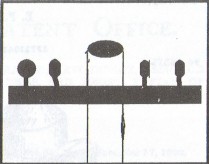
Although an early experimental radio transmission was made in Germany by Hertz
in 1886 and speech was first broadcast in 1906, the first regular radio
broadcast stations were not operational until 1921. The receiving equipment was bulky, relatively expensive
and outputted to headphones only. It was not until the widespread introduction
of the loudspeaker (courtesy of Rice and Kellogg in the U.S.A.), that radio
really took off, in the mid-1920's.
It appears to have been common practice in
urban areas of England to "pipe" the radio signals from a central
receiver (usually in a local radio shop) to houses, cinemas and factories.
Presumably it made economic sense at the time, and also many premises were not
connected to main's electricity until many years later. Thus the idea of cable
TV is not a recent one.
The radio relay systems included transmission lines and
insulators were installed by private contractors, who were quite independent of
the broadcast stations (The BBC) and from the telephone company (GPO). I believe
the lines and equipment were leased to the individual listeners. These local
radio relay networks continued to be used until after the Second World War. The
advent of television and the transistor radio, no doubt providing too much
competition, most relay systems fell into disuse and were dismantled in the
1960' s. The copper wire went for scrap but many an insulator still remains.
The three known radio relay types are illustrated here. Examples of the tall
insulator were retrieved for me by the local telephone company (British Telecom:
York) with the aid of a crane, and I must thank Les Wareham for their safe
removal. All of the insulators found were manufactured from porcelain and glazed
in various shades of brown. Some were marked "MADE IN ENGLAND" and
others had the Bullers Ltd. trademark. One was dated 1949, but other examples
seemed to pre-date this and are probably some original 1920/1930 types.
Just why
these insulators have been designed in such complex shapes is a bit of a
mystery. The small radio relay insulator is somewhat similar to U-1898 but is
smaller and much more complex. The tall insulator and the corrugated type have
never before been documented, even in Keith Neal's books on British telegraph
insulators.
It's a great feeling to be able to discover something which has
remained forgotten for years, and even better to be able to bring the results of
this research to a wider audience. Not to mention a few further additions to my
growing British porcelain collection! The author would like to thank Carol of
"Crown Jewels" for her encouragement to write this article.
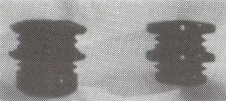
Colour variations - from black
glaze, to a red glaze on a Dry Spot
(Pot Head)
Terminator type.
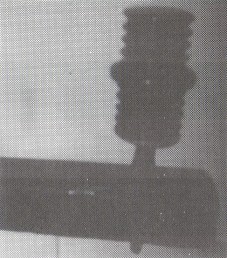
"Tall" type radio relay insulator,
dark brown glaze, on spindle.
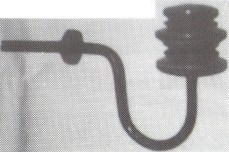
"Short" type radio relay insulator in
chestnut brown glaze on U-shaped pin.
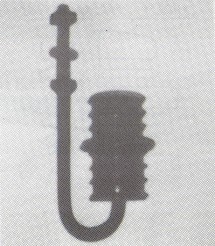
A slightly smaller variation of the
"tall" type on an underarm
spindle.
| 